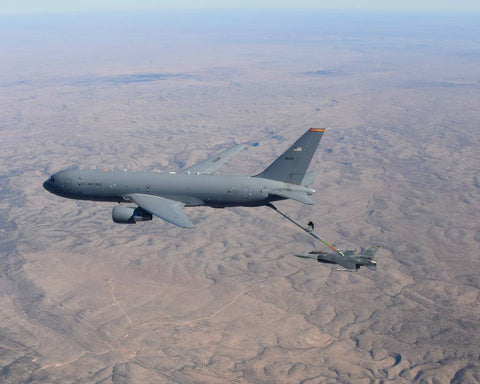
What’s Gone Wrong — And Right — With Boeing KC-46A Pegasus Tanker?
The U.S. Air Force needs more flying tankers to bridge the gap between current capabilities and the next-generation KC-Z refueling aircraft it is planning. The Boeing KC-46A is one option, as is Lockheed Martin’s LMXT, which is a modified version of Airbus A330 Multi Role Tanker Transport.
The following are frequently asked questions about the KC-46A.
What is the KC-46A Pegasus?
The KC-46A Pegasus is the latest Boeing-designed tanker used for mid-air refueling of aircraft. In development for more than a decade, the KC-46A takes on operations previously handled by the KC-135 Stratotanker and KC-10 Extender. It features boom and hose-and-drogue systems that are able to refuel all U.S., allied and coalition military aircraft compatible with international refueling procedures.
Who makes it?
The Air Force first contracted with Boeing in 2011 to manufacture 179 KC-46A′s to begin modernizing and replacing the Air Force’s almost 50-year-old KC-135 fleet. Manufactured at Boeing’s factory in Everett, Washington, the KC-46A is a variation of the Boeing 767 commercial passenger aircraft, and will come off the line as a “767-2C Provisioned Freighter that will eventually become a military-configured KC-46 tanker,” according to the 88th Air Base Wing at Wright-Patterson Air Force Base.
Is the KC-46A in service?
The KC-46A had flown more than 9,000 sorties and offloaded more than 78 million pounds of fuel, according to information provided by Boeing. It’s capable of holding more than 210,000 pounds of fuel at take-off.
Have there been problems with the KC-46A tanker?
Unlike the KC-135 and KC-10 it is designed to replace, the KC-46A refuels aircraft with its operators using a Remote Vision System of cameras and sensors to guide the boom into the aircraft being refueled.
The aircraft has been riddled with technical issues due to problems with the RVS, costing Boeing billions to fix and delaying its fuller integration into the Air Force.
The cameras and sensors often could be distorted or difficult to view under certain light conditions, so tankers ran the risk of scraping the boom along aircraft mid-flight. The Air Force designated the problem as a category I deficiency, one of the most serious issues with an aircraft.
In January, Boeing recorded a 14 percent drop in its defense business sales, partially due to the poor performance and technical issues of the KC-46A.
What is being done to address the RVS issue?
This past April, Boeing agreed to a plan with the U.S. Air Force that would replace the RVS with a new system ― the Remote Vision System 2.0. Air Force spokeswoman Capt. Samantha Morrison told Defense News in a statement that Boeing would cover the costs of the new RVS 2.0 updates needed for the KC-46A.
Are the fixes working?
With its initial flight in December 2014, the KC-46 only got its first interim capability release mission ― a test of what aircraft can be refueled by the plane ― on July 9 of last year after technical RVS issues. By May of this year, a KC-46 at McConnell Air Force Base in Kansas completed 24.2 hours of flight time, a program record.
Today, the KC-46A now has capability to support 97% of joint force air refueling demands, according to a June 1 statement from U.S. Air Mobility Command.
“Credible and reliable KC-46A tanker capability is now available to our joint and international partners,” Gen. Mike Minihan, commander of Air Mobility Command, said in a statement. “In May 2021, the KC-46A was not cleared to operationally support any [U.S. Transportation Command] missions. With a team of incredible professionals across the enterprise analyzing the data and making risk-informed decisions, we’ve deliberately and aggressively accelerated the Pegasus’ operational use.”
How many KC-46A tankers does the Air Force want?
The Air Force has asked Congress to lower the minimum number of tankers needed in the Air Force’s tanker fleet. Congress set the minimum number of tankers needed in case a war broke out at 479 in the 2019 National Defense Authorization Act, which was based on a U.S. Transportation Command study in 2018.
Air Force Secretary Frank Kendall, at a Heritage foundation event, said that he believes 455 tankers would be adequate to counter adversaries.
How much has the KC-46A program cost?
The tanker has officially cost Boeing more to fix than the total price of the contract it signed with the Air Force. Since that first flight in 2014, Boeing has regularly had to pay charges to fix issues with tanker, such as the RVS system. While Boeing first signed a $4.9 billion deal with the Air Force to build the tanker, the company has accumulated more than $5 billion worth of charges to due the technical issues.
Originally published by Military Times, our sister publication.
